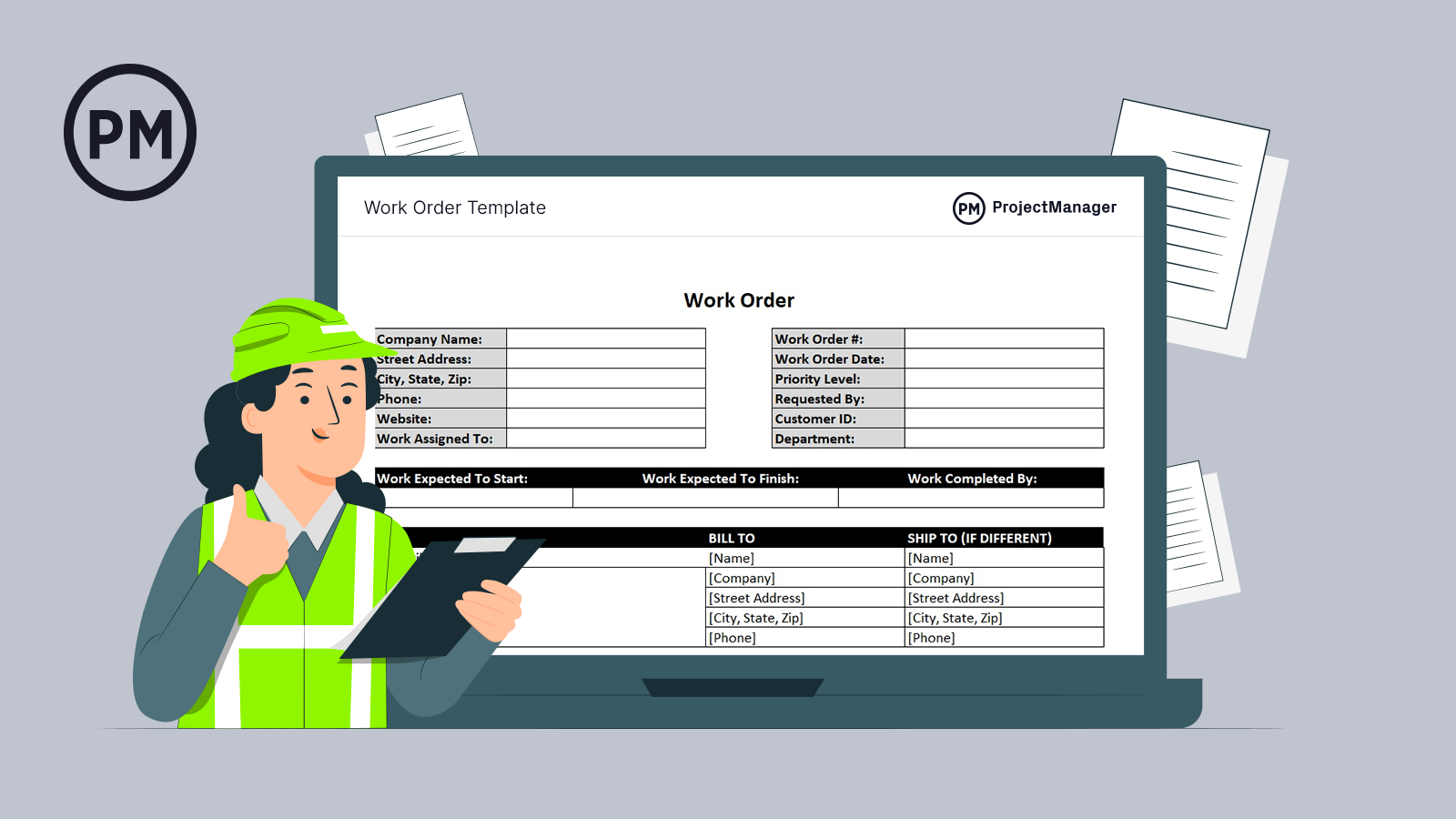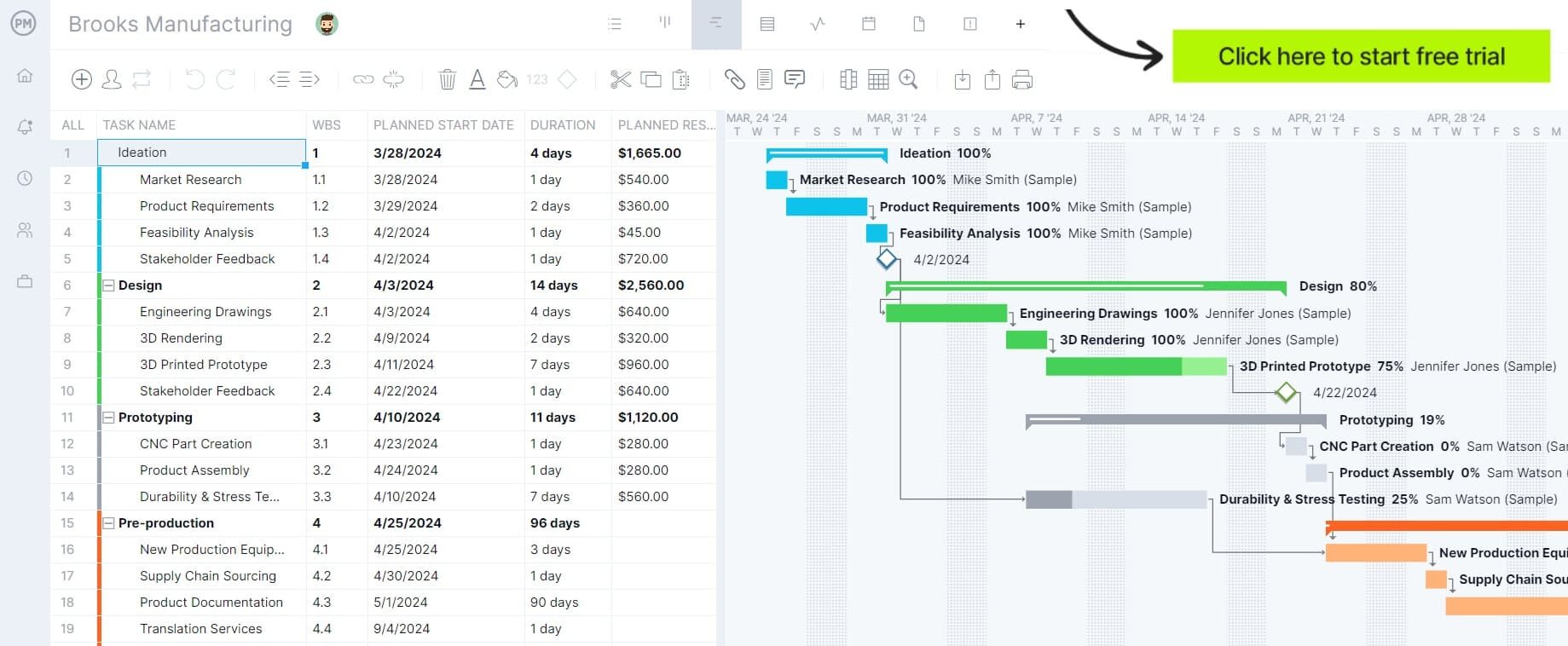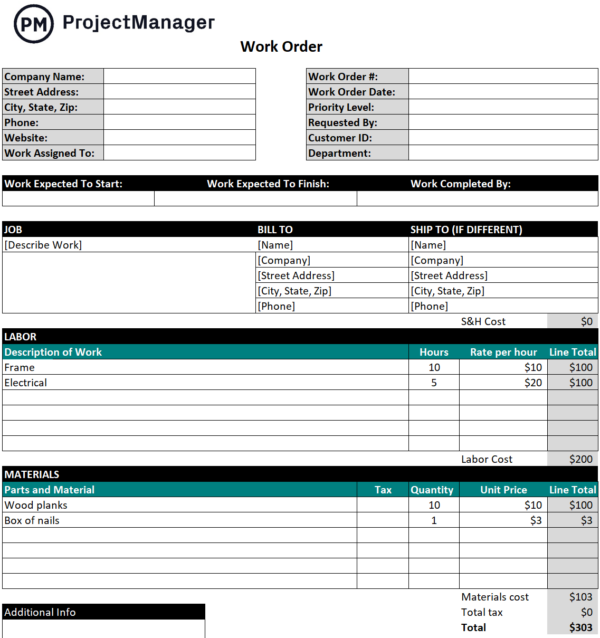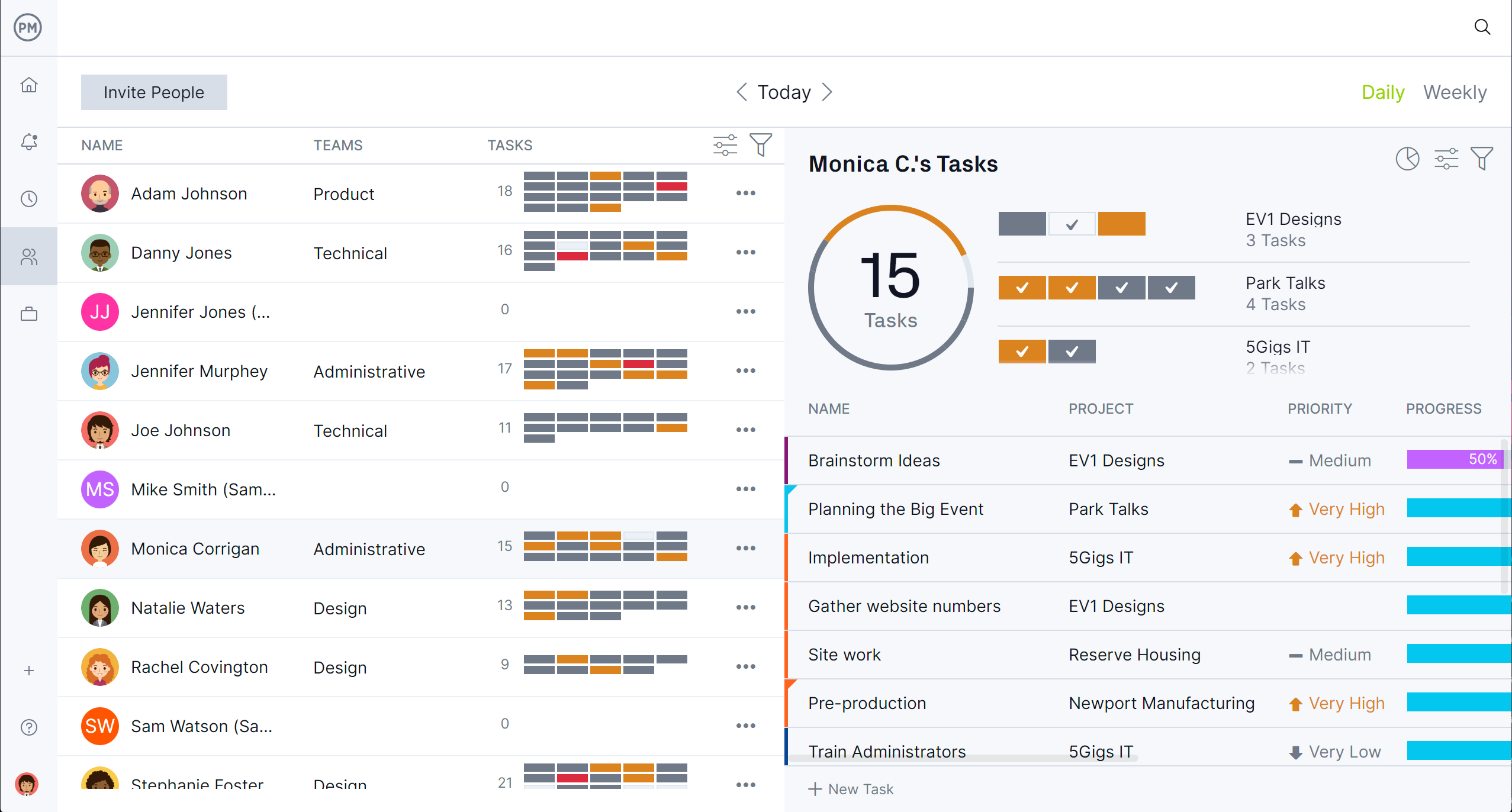Manufacturers deal with complex operations every day, from scheduling production runs to tracking raw materials and ensuring delivery deadlines are met. With so many moving parts, it becomes critical to have a structured way to organize and assign the work that keeps production flowing smoothly. That is where tools designed to streamline the process play a central role in keeping operations efficient and accountable.
A manufacturing work order is one of the most important documents on the shop floor because it connects planning with execution. It makes sure that teams understand what needs to be made, when it needs to be completed and which resources will be used. Without a clear framework, production can stall, mistakes can multiply and valuable time can be lost. By using the right system, manufacturers can stay on top of every detail and drive better outcomes.

Get your free
Work Order Template
Use this free Work Order Template to manage your projects better.
Get the Template
What Is a Manufacturing Work Order?
A manufacturing work order is a structured document that communicates the details of a specific production job. It outlines what product needs to be made, the quantity required and the materials, equipment and labor needed to complete the task. This document acts as a bridge between planning and the actual production process, making sure all team members are aligned on what needs to be delivered. With clear instructions, workers can reduce mistakes and avoid unnecessary delays on the shop floor.
Beyond just instructions, a manufacturing work order also creates accountability and traceability across the production cycle. It can document start and finish dates, identify who is responsible for the work and track progress along the way. This information not only ensures that production runs as expected but also provides valuable data for future planning, cost management and process improvement. Having this level of clarity allows manufacturers to better manage resources and deliver on customer demand.
While traditional work orders often rely on static documents or spreadsheets, project management software makes the process more dynamic and efficient. It centralizes work orders in a single system where teams can collaborate, update status in real time and track resource use against planned schedules. This reduces the risk of missed deadlines and makes it easier to adapt when priorities shift or unforeseen issues arise. With integrated tools, managers gain visibility into workloads, dependencies and bottlenecks, allowing them to act quickly and keep production on track.
ProjectManager is award-winning project and portfolio management software for managing manufacturing work orders and more. Its Gantt charts help schedule and sequence tasks while Kanban boards provide a visual workflow for shop floor teams. Resource management tools ensure that materials, machines and people are allocated effectively, while real-time dashboards give managers instant visibility into progress and performance.
With our software, manufacturers get an end-to-end platform that not only handles work orders but also strengthens overall production management, helping teams deliver faster with fewer errors. Get started with ProjectManager today for free.

What Should Be Included In a Manufacturing Work Order?
A manufacturing work order is only effective when it contains all the essential details needed to guide production from start to finish. A complete manufacturing work order ensures that every team member knows exactly what is expected at each stage of the process. By including clear instructions, labor and material requirements, cost estimates and scheduling information, managers can minimize confusion, reduce errors and improve overall efficiency.
Authorization and tracking details in a manufacturing work order add accountability and make it easy to monitor progress, helping prevent delays and ensuring consistent quality. Without a detailed manufacturing work order, production teams risk miscommunication, wasted resources and missed deadlines, which can negatively affect both costs and delivery schedules.
Task or Work Description
The task or work description section of a manufacturing work order outlines the specific work that must be performed in clear, concise language. This ensures operators and production staff understand the objectives and steps required for each manufacturing work order. Detailed instructions help teams avoid errors, maintain quality standards and complete work orders according to specifications. Including diagrams, reference numbers or example outputs within the manufacturing work order can further enhance clarity and reduce misinterpretation during production.
Labor Requirements
Labor requirements in a manufacturing work order identify the personnel needed to execute the work efficiently. This includes the number of workers, their skill levels and any certifications required. By specifying labor needs in the manufacturing work order, managers can allocate the right people to each task, prevent bottlenecks, optimize productivity and reduce labor costs. Clear labor requirements also make it easier to schedule shifts and plan for contingencies in case of absenteeism or unforeseen challenges during production.
Materials and Parts Requirements
The materials and parts section of a manufacturing work order lists all necessary components, quantities, specifications and preferred suppliers. Properly detailing materials in a manufacturing work order prevents shortages, avoids production delays and ensures smooth execution of tasks. Including this information also aids quality control and allows managers to track inventory against work order requirements, preventing overstock or wastage and improving operational efficiency.
Estimated Cost
Estimated cost information in a manufacturing work order provides a breakdown of labor, materials and overhead expenses. Accurate estimates help managers budget appropriately, evaluate project feasibility and compare actual costs to projections. Including cost data in the manufacturing work order allows teams to make informed decisions about resource allocation, plan priorities and track profitability while minimizing financial risks during production.

Schedule and Due Dates
Including a schedule and due dates in a manufacturing work order ensures production stays on track and resources are used efficiently. This section helps teams prioritize tasks, coordinate multiple work orders and align with overall production goals. Clear timelines in a manufacturing work order allow managers to monitor progress, identify bottlenecks and adjust plans as needed to meet deadlines, especially in high-volume or time-sensitive manufacturing environments.
Authorization and Tracking Details
The authorization and tracking details in a manufacturing work order document include who approved the work and provide a system to monitor progress. This ensures accountability and allows managers to review completion status, identify deviations and take corrective actions. Proper authorization and tracking in a manufacturing work order enhances transparency, supports compliance with company policies and industry standards, and improves overall operational efficiency by creating a clear record of all production activities.
Manufacturing Work Order Template
Download this free manufacturing work order template for Excel. It’s designed to streamline task management. This template helps you organize requested tasks, create detailed work orders and maintain smooth project workflows. It’s suitable for various industries, ensuring clarity and consistency in work order documentation.

Using this template allows you to capture essential details such as task descriptions, labor and material requirements, estimated costs and schedules. By standardizing work orders, you can enhance communication, reduce errors and improve overall efficiency in your manufacturing processes.
Types of Manufacturing Work Orders
Manufacturing work orders can vary depending on the type of task, desired outcome and industry requirements. Each type of manufacturing work order serves a specific purpose, whether it involves standard production, equipment maintenance or managing defective items.
Understanding different types of manufacturing work orders allows managers to assign the correct work order for each situation, streamline workflow and improve efficiency. Proper classification also helps teams prioritize tasks, allocate resources effectively and ensure consistency across production processes.
Production Work Order
A production work order is used to plan, track and execute the creation of goods. It details the steps, materials and labor required to produce finished products according to schedule. By clearly specifying production tasks, a manufacturing work order ensures every team member understands their role in the process. Production work orders also provide documentation for quality control, inventory management and cost tracking, making them essential for operational efficiency and meeting customer expectations.
Rework Order
Rework orders are issued when a product requires corrections or modifications due to defects. A rework manufacturing work order guides staff through the steps needed to fix issues and bring items up to quality standards. It includes detailed instructions, required materials and labor needed to complete the task. Rework work orders help reduce waste, maintain customer satisfaction and improve overall product quality by ensuring defects are addressed systematically and efficiently.
Preventive Maintenance Work Order
Preventive maintenance work orders schedule regular maintenance tasks to prevent equipment breakdowns and ensure smooth production. These manufacturing work orders include instructions on maintenance tasks, required tools and labor assignments.
Implementing preventive maintenance work orders reduces downtime, extends the lifespan of machinery and maintains consistent production output. They also support safety protocols by ensuring equipment operates reliably and potential issues are addressed before causing significant problems.

Corrective Maintenance Work Order
Corrective maintenance work orders address unexpected equipment failures. A corrective maintenance manufacturing work order outlines the steps to repair machinery, identifies necessary parts and assigns skilled personnel to restore operations quickly.
These work orders minimize production interruptions, maintain quality standards and ensure schedules remain on track. Documenting corrective actions in manufacturing work orders provides valuable data for future maintenance planning and helps prevent recurring equipment issues.
Setup or Changeover Work Order
Setup or changeover work orders manage transitions between production runs. They detail machine adjustments, labor assignments and materials required to switch from one product type to another. A setup manufacturing work order reduces downtime, prevents errors and ensures each production run meets quality specifications. It also provides a record of the changeover process, helping teams improve efficiency and identify opportunities for process optimization in future runs.
Scrap Work Order
Scrap work orders track the disposal or recycling of defective or excess materials. A scrap manufacturing work order documents reasons for scrapping items, the quantity involved and proper disposal methods. These work orders ensure compliance with company policies and reduce environmental impact. Recording scrap data in manufacturing work orders allows managers to identify trends, analyze root causes of defects and implement corrective actions to reduce waste and improve overall manufacturing efficiency.
Related: 10 Best Production Planning Software
Manufacturing Work Order Example
The best way to understand how a manufacturing work order looks is to go through a real-life scenario example.

This example shows a complete manufacturing work order, formatted the way most plants run jobs on the floor. It covers the job’s scope, routing, labor hours, materials, cost estimates, schedule and approvals, with realistic notes for quality, testing and labeling. Use it as a reference when drafting your own work orders, training planners and supervisors, or aligning ERP and MES fields with shop-floor travelers. Adapt quantities, rates and dates to your product, then attach relevant drawings, BOMs and change notices.
More Free Manufacturing Templates
These free manufacturing templates help streamline processes and improve efficiency across different operations. Each template provides structure and guidance, making it easier for teams to plan, track and execute tasks consistently while reducing errors and saving time.
Production Schedule Template
Download this free production schedule template to organize manufacturing tasks, assign responsibilities and track progress. It ensures that production stays on schedule and resources are used efficiently.
Inventory Template
Use this free inventory template to monitor stock levels, track materials and manage reorder points. It helps prevent shortages or overstock and keeps production running smoothly.
SIPOC Template
This free SIPOC template maps out Suppliers, Inputs, Process, Outputs and Customers. It gives a clear overview of processes, highlights areas for improvement and supports better decision-making in manufacturing.
How ProjectManager Helps Manage Manufacturing Work Orders
ProjectManager streamlines the management of manufacturing work orders by providing multiple project views that fit every workflow. Teams can switch between Gantt charts, kanban boards and task lists to plan, schedule and visualize manufacturing work orders. This flexibility ensures managers and operators stay aligned, track progress in real time and quickly respond to changes in production schedules, keeping every work order on track. Watch this short video to learn more about our software.
Optimize Resource Management
ProjectManager lets you assign tasks, balance workloads and allocate labor and materials efficiently for each manufacturing work order. By monitoring resource availability and utilization, teams can prevent bottlenecks, reduce downtime and ensure the right personnel and equipment are applied to every manufacturing work order, improving overall productivity.

Track Work Orders in Real Time
With ProjectManager’s dashboards, timesheets and customizable reports, you can track manufacturing work orders from start to finish. Managers can review completion status, monitor costs and analyze performance metrics for each manufacturing work order to make data-driven decisions and continuously improve production efficiency.
Related Content
Explore more resources to improve your production operations management. Below are links to articles on project and manufacturing KPIs, metrics, software and more.
- 20 Production and Manufacturing KPIs & Metrics
- 12 Best Production Scheduling Software for Manufacturing Companies
- Production Scheduling Basics: Creating a Production Schedule
- Production Tracking: Monitoring the Success of Your Manufacturing Process
- How to Improve Production Efficiency in Manufacturing
ProjectManager is online project and portfolio management software that connects teams whether they’re in the office or out in the field. They can share files, comment at the task level and stay updated with email and in-app notifications. Get started with ProjectManager today for free.

